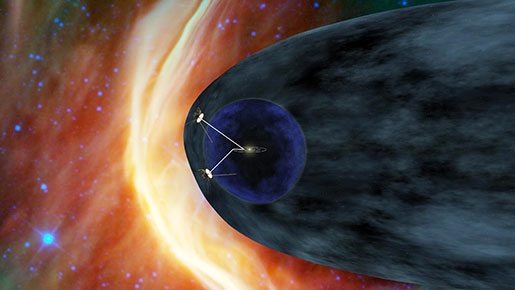| Sep 12, 2013 |
Voyager's departure from the heliosphere
|
|
(Nanowerk News) New data from NASA's Voyager 1 spacecraft, which has been hurtling away from the Sun since it was launched in 1977, indicates that the spacecraft has indeed left the comfort of the heliosphere—the bubble of hot, energetic charged particles surrounding the Solar System—and entered into a region of cold, dark space, known as interstellar space. Based on these new measurements, which show that plasma densities around the spacecraft are consistent with theoretical predictions of the interstellar medium, researchers suggest that Voyager 1 arrived in this cold, unexplored interstellar region on or about 25 August, 2012.
|
|
The Voyager 1 spacecraft uses myriad instruments onboard to send data back to Earth, and scientists have been waiting for certain measurements—namely, a drop in solar particles and a spike in galactic ones—to alert them to Voyager 1's passage through the heliopause, or the boundary between solar plasma and the plasma of interstellar space.
|
|
A recent study by Swisdak et al. published in The Astrophysical Journal Letters described some particle changes and used a theoretical model to interpret Voyager data. The model focused on the mechanism connecting the solar and interstellar magnetic fields together at the heliopause, and the researchers proposed that changes detected in the energetic particles around the spacecraft were signatures of related reconnection processes.
|
|
Now, however, Don Gurnett, principal investigator of Voyager's plasma wave science instrument at the University of Iowa, Iowa City, and a team of colleagues provide measurements of electron plasma oscillations—measurements that were not possible in previous studies—between 9 April and 22 May of this year, revealing that Voyager 1 was in a region of space with an electron density of about 0.08 per cubic centimeter. And, according to current models, the density of electrons in the interstellar medium should be between 0.05 and 0.22 per cubic centimeter.
|
|
The report by Gurnett et al. is published in the 12 September issue of Science Express ("In Situ Observations of Interstellar Plasma With Voyager 1").
|
 |
| This artist's conception shows the two Voyager spacecraft exploring the heliosphere (shown in gray). Researchers suggest that Voyager 1 may have recently entered into the previously unexplored interstellar space (shown in orange), a cold dark region beyond our solar system. (Image: NASA/JPL-Caltech)
|
|
"Now that we have new, key data, we believe this is humankind's historic leap into interstellar space," said Ed Stone, Voyager project scientist based at the California Institute of Technology, Pasadena. "The Voyager team needed time to analyze those observations and make sense of them. But we can now answer the question we've all been asking: 'Are we there yet?' Yes, we are."
|
|
To understand if Voyager 1's historic passage through the heliopause could have happened prior to April of 2013, Gurnett and his colleagues looked back at older data from Voyager 1, identifying another interval of electron oscillations that was similar to the April-May, 2013 event. It occurred between 23 October and 27 November, 2012. They calculated that the electron density surrounding the spacecraft during that time was about 0.06 per cubic centimeter, and they say that the change in density between the two events—from 0.06 to 0.08—indicates a smoothly increasing plasma "density ramp" in the region of space between them. Since Voyager 1 is traveling at about 3.5 astronomical units per year, the researchers suggest that electron density increases by about 19% for every astronomical unit along this density ramp.
|
|
"We literally jumped out of our seats when we saw these oscillations in our data—they showed us that the spacecraft was in an entirely new region, comparable to what was expected in interstellar space, and totally different than in the solar bubble," said Gurnett. "Clearly we had passed through the heliopause, which is the long-hypothesized boundary between the solar plasma and the interstellar plasma, probably in August of 2012."
|
|
To gain further clarity regarding the crossing of Voyager 1 into the interstellar medium, Gurnett and his colleagues eventually referred back to a Science report that Gurnett had co-authored back in 1993. The report took advantage of a series of intense solar storms that sent a shockwave through the heliosphere. It explains that, 400 days after the storms, the researchers detected a resulting radio emission—starting at a frequency of two kilohertz—when the shockwave collided with the heliopause at an estimated distance of 116 to 117 astronomical units from the Sun.
|
|
The researchers followed the slope of their density ramp backward in time until the frequency of their readings matched two kilohertz. The ramp led them back to August, 2012, and since 25 August, 2012 coincides with declines in the intensity of charged particles and spikes in the intensity of galactic cosmic rays, they suggest it as the most likely date of interstellar arrival—at approximately 121 astronomical units from the Sun.
|
|
"Voyager has boldly gone where no probe has gone before, marking one of the most significant technological achievements in the annals of the history of science, and as it enters interstellar space, it adds a new chapter in human scientific dreams and endeavors," said John Grunsfeld, NASA's associate administrator for the Science Mission Directorate. "Perhaps some future deep space explorers will catch up with Voyager, our first interstellar envoy, and reflect on how this intrepid spacecraft helped enable their future."
|
|
"Even though it took 36 years, it's just an amazing thing to me," said Bill Kurth, from the University of Iowa, a co-author of the Science paper. "I think the Voyager mission is a much grander voyage of humankind than anyone had dreamed—to not only leave the Earth and tour the giant outer planets, but now to venture into interstellar space for the first time."
|
|
"The holy grail of heliospheric research has been to reach the heliopause," said Gurnett. It now seems certain that Voyager 1 has accomplished that mission.
|

